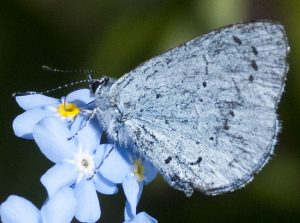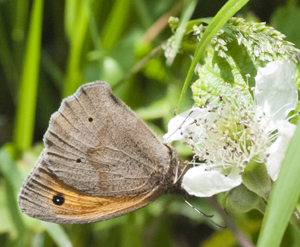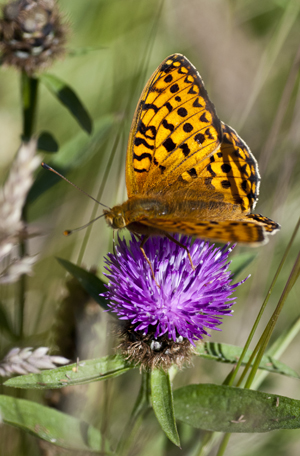Woodland moths and butterflies.

There are many types of woodland, which may be broadly categorised by the dominant type of tree(s) - thus there is, birch woodland, oak woodland, beech woodland etc. The flora and fauna of these different types of woodland varies though there can be similarities. Some species, such as brambles and ivy can live in a variety of conditions whilst other plants / animals have very specific requirements.
This is certainly true for various animal species - for example, butterflies and moths. For example, the Brimstone (a pale yellow butterfly) has larvae (caterpillars) that need to feed on Buckthorn and Alder Buckthorn. These are shrubs that both occur in wet woodland, but buckthorn also occurs also on dry chalk and limestone soils. Native pine woodland, not always thought of as the most biodiverse habitat, does however support distinctive moth populations (e.g. the pine tree lappet).
However, it is deciduous lowland woodlands that can offer a rich variety of habitats if they are managed to offer a diverse structure, coupled with a changing supply of open areas. A woodland that is ‘good’ for butterflies and moths is one with a diverse and uneven structure, and one that changes. Such a woodland would include
- mature / tall trees
- patches of cleared, open areas
- areas where dense regrowth is occurring
- glades and rides, where the sun can reach.
 Such a managed woodland offers a range of micro-habitats :
Such a managed woodland offers a range of micro-habitats :
- where adult butterflies can fly,
- where eggs can be laid,
- where caterpillars can feed and
- pupae can develop undisturbed.
The habitat requirements of each stage of a butterfly’s life cycle [egg - larva (caterpillar) - pupa (chrysalis) - adult (imago) ] may be very different. As an adult, a butterfly generally requires warmth and flowers with nectar, whereas a larva / caterpillar feeds voraciously and needs a plentiful supply of food (be it leaves of oak or those of a herbaceous plant).
In order for a woodland to offer this range of micro-habitats, it needs to be managed and managed continuously - rather like the productive woodlands of old, when coppicing was extensively practised. Coppicing was the principal form of woodland management over much of the lowland areas of the U.K., till the end of the 19th century. Coppice produced a regular crop of timber and woodland products. Coppicing is thought to date back into ‘prehistory’, certainly the Domesday Book indicates that its practice was widespread at that time. The abandonment of coppicing is thought to have been a major factor in the decline of several moth and butterfly species - notably the woodland fritillaries.
 A management plan for butterflies might include some or all of the following :
A management plan for butterflies might include some or all of the following :
- restoration of a coppicing cycle
- establishment / re-introduction or ‘restoration’ of rides and glades
- removal of non-native trees / flora
- protection / nurturing of ancient / veteran trees
- thinning of canopy
- reduction of browsing by deer
- allowing deadwood resources to increase (home for saproxylic beetles etc)
- new planting to augment age structure of woodland
- creating wetland features / areas
In creating and managing woodlands for butterflies, the mosaic of different habitats will also offer greater opportunities for moths (a more diverse group than butterflies), who ‘exploit’ a wider range of food plants and niches than butterflies.
Detailed information on woodland management for butterflies and moths can be found here at www.butterfly-conservation.org
Comments are closed for this post.
Discussion
[…] Firstly, many woodlands are no longer actively managed, for example, through coppicing. Consequently, the canopy can become more complete, that is denser – the woodland becomes generally darker and many species that rely on the ‘younger‘ stages of woodland growth lose their habitat / niche. Certain woodland plant species need the open spaces of glades, rides, newly coppiced areas – which fill with light and sunshine, for their seeds to germinate and grow to maturity. Snakes such as the adder need ‘open areas’ in which to bask, to warm up in the sun. An area that is regularly coppiced will see an increase in light intensity (at the ground / herb layer) and a ˜flush of woodland flowers in the immediate post-coppicing period. Coupled with this, there is often a population boom of butterflies that depend on these plants for nectar, places to lay eggs etc. (see previous blog). […]

[…] as creating a structurally diverse woodland is good for butterfly / moth biodiversity, so it is good in terms of robustness. Variation in age and structure is good for resilience / […]
Woodlands, climate and robustness. | Woodlands.co.uk
16 April, 2018